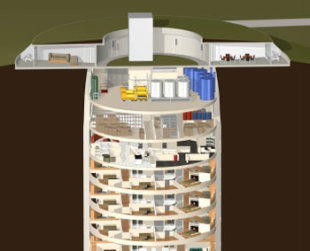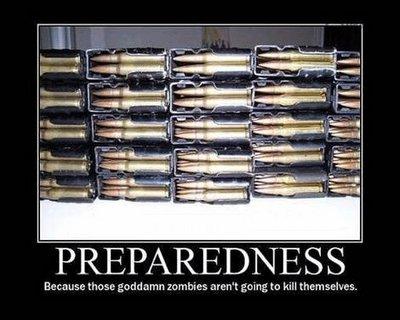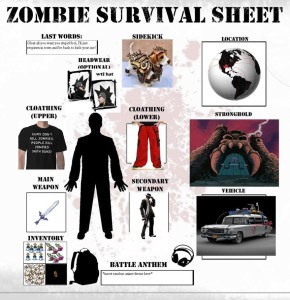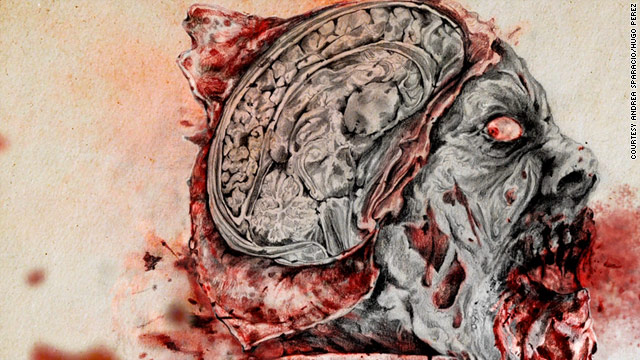Tag Archives: zombies
Zombie-proof condos all sold out in Kansas, Canadians still have options
The units built out of an old missile silo had a list price of $2 million
If you are looking for something to protect yourself when zombies attack, we may have found just the abode for you. The only problem: the zombie-proof condos in Kansas have all sold out.
found just the abode for you. The only problem: the zombie-proof condos in Kansas have all sold out.
According to the Survival Condo website, all eight units have been purchased, although one sale is still pending.
The 1,820-square-foot condos come with an indoor pool (definitely not above ground) and spa, exercise facility, classroom, library, movie threatre, minor surgery centre and an elevator. Owners also get off-the-grid power thanks to a wind turbine and solar panels. Next to the sold notice, the website also states that they “now have an in-house dentist/orthodontist!!!!” on level 3a. Oh and did we mention it comes with a weapons cache.
All of this went for $2 million for a full floor.
The place was rated by Mother Nature Network as one of the “best U.S. places to survive the apocalypse.”
The condos weren’t dug into the ground, but are made from an old missile silo in Concordia, Kansas. The silo was build to withstand a nuclear explosion and according to Rocket City News is considered to be “one of the strongest structures built by man.”
“Construction is well under way,” reads the Survival Condo website. “The new steel structure is built and the top five floors are poured and being built out for the owners. The new septic system is complete and the new water system is nearing completion.”
If you weren’t one of the people who were able to purchase a zombie-proof home, the B.C. government has put together some advice on fending off the brain eaters. It recommends having a full gas tank, having an emergency kit in your home, office and car and having an out-of-province contact.
It launched a blog on the Emergency Info BC website in May to tell people what to do in case of a real emergency such as an earthquake, flood or tsunami.
A recent survey found nine per cent of Canadians believe the Mayan prediction that the world will end in 2012. In the event this minority’s belief is correct, escaping into a bunker is an option in Canada. Bruce Beach has built the world’s largest privately-constructed nuclear fallout shelter in Horning’s Mills, Ont., about an hour and a half from Toronto. It’s called Ark Two. The shelter is constructed from the shells of 42 school buses, which were buried underground in the 1980s as moulds for the poured concrete bunker.
(Image from Survival Condo)
OUR GOVERNMENT IS LYING – CDC denies rumors of zombie apocalypse
CDC denies rumors of zombie apocalypse
With reports of flesh-eating coming in from across the nation, rumors of a possible zombie outbreak are spreading on the Internet — but do you really have anything to worry about?
 Photo: Nemanja Jovanovic/AFP
Photo: Nemanja Jovanovic/AFPThe dangers of bragging about your zombie defense preparation
 You are prepared for the zombie apocalypse.
You are prepared for the zombie apocalypse.
You’ve stocked up on canned goods and ammunition. Your fortified treehouse is built high in the Rocky Mountains. You’re an expert marksman proficient in several different kinds of firearms. You’ve got your pilot license, your Wilderness EMT training, your black belt in Judo, and you’ve won the blue ribbon at the county fair three years running for your green thumb. You know how to make a weapon out of three paperclips and a crumpled Reese’s Peanut Butter Cup wrapper, and you can survive on nothing but tree bark and fingernail clippings for weeks.
You, sir or madam, are prepared for the day when the dead replace the living as the dominant species on Earth and theBRAAAAINS hit the fan. But that doesn’t mean you need to advertise the fact.
It might be tempting to brag to all your friends and neighbors (the ones you haven’t carefully selected as your zombie apocalypse companions for their special skills and ability to remain calm in the face of gruesome death) about how ready you are for the eventuality of zombies. But you must resist the temptation.
Those same people who consider you their “crazy zombie-obsessed friend” today will turn to you for help when the need arises. And when the need arises, corpses will be feasting on the living in the streets and society will face a swift and brutal collapse, so it’s fair to say that those less prepared than you will not be at their most rational or diplomatic.
Being burdened with several unprepared would-be survivors could spell doom for any meticulously planned survival strategy. These are the people who considered your little zombie fixation an “adorable quirk” and tolerated your defense preparations because you were their friend. They have done nothing on their own to make them a valuable asset in the post-zombiepocalyptic world. And they will drag you down.
At the first sign (Or maybe the second or third, since let’s face it: People tend to resist the most obvious explanation) of a zombie outbreak, these acquaintances will come running to you for help. They won’t know that they are merely zombie fodder waiting to happen, but you will. You cannot let them slow you down.
So keep your zombie defense preparations to yourself as much as possible. Don’t go bragging about how you’ll be living large on SPAM for years while they’re shambling about munching on carrion… and being carrion. It might feel good to boast now, but when that government experiment goes awry and corpses start clawing their way up from the grave, you don’t want to be saddled with a bunch of under-prepared dead weight.
Unless you like the idea of using bait, that is.
Stay informed, stay alive: What are some of your zombie defense preparations? Don’t worry, I won’t tell those pesky neighbors who laugh at you for your underground bunker now but will be moaning and shambling about your yard a minute after the first sign of a zombie outbreak.
How to Survive Miami’s Zombie Apocalypse, According to Zombie Expert Jonathan Maberry
 According to authorities, there’s a good chance that last week’s face-eating incident was the result of mind-altering drugs. (Just say no, kids.)
According to authorities, there’s a good chance that last week’s face-eating incident was the result of mind-altering drugs. (Just say no, kids.)
But according to the rest of us, it may signal the beginning of an inevitable threat Hollywood has warned us about for years: a zombie apocalypse. (Just ask The Miami zombie.)
Naturally, we’re all a little concerned that the undead may choose our sunny paradise as their next city of smorgasbord. After all, the heat is nice and lubricating for their stiff limbs.
So, in the interest of being prepared, we spoke to zombie expert Jonathan Maberry, author of Zombie CSU: The Forensics of the Living Dead on how best to survive a zombie apocalypse. Y’know, just in case.
Cultist: I’m sure you heard about the recent face-eating zombie attack in Miami. Any commentary?
Maberry: Within a few hours of the report hitting the news I was inundated by emails, IMs, Facebook and Twitter posts telling me, in essence, that the stuff I’ve been writing may not be fiction.
What would you say is the top rule of zombie survival?
Don’t be the dumb loudmouth in your group of survivors. These days, folks are likely to feed you to the zoms and make their escape during the chow-down.
What weapons or supplies should we procure to prepare ourselves?
In my series of teen post-apocalyptic zombie novels (Rot & Ruin, Dust & Decay, etc.) the smartest object of defense isn’t a gun or knife — it’s body armor made from carpet. You can’t really bite through it and there’s carpet everywhere. In the movies, the characters always run out into a crowd of zoms wearing ordinary clothes. I’d tear up the carpet, secure it with some duct tape (and we all have duct tape), and then stroll through the crowd of frustrated zombies.
Can we ply them with any other food besides human flesh?
If we accept the movies of George Romero as “zombie canon,” then the living dead eat everything — humans, animals, insects. We can always breed food for them. And it would provide jobs for farmers in a troubled economy.
How do zombies react to hot weather?
Zombies would thrive in hot weather. The heat keeps them limber. Cold would freeze them solid since body heat comes from blood flow. Of course, as the temperature rises, the zoms would spoil pretty quickly. Smelly … but eventually they’d fall apart.
Can zombies swim?
Zombies wouldn’t be a threat in the water. The freshly killed ones would sink like a stone without air in their lungs for buoyancy. The rotting ones might float because of gasses released by putrefaction, but they would lack the coordination for the mechanics of swimming and couldn’t strategize on how to overcome tides and currents. So, a great way to survive the zombie apocalypse is to strap on that Speedo and take a dip.
Are there different varieties of zombie?
There are several classifications of zombies. The old-school zombies are the raised dead used as slaves by priests of the Haitian religion of vodou. Since the 1960s we’ve come to hang the “zombie” nickname on flesh-eating ghouls of the Romero kind, and these are slow-moving, mindless corpses. Then there are the fast zombies, as introduced first in the film Return of the Living Dead (1985) and made famous in the 2004 Zack Snyder remake of Dawn of the Dead. Then you have the “rage virus-infected,” who are mindless humans infected by a disease that makes them kill everyone they meet. They were first introduced in George Romero’s 1973 flick The Crazies, then later became wildly popular in Danny Boyle’s 2002 classic, 28 Days Later and the 2010 remake of The Crazies. Oh, and Europe is famous for its demonically possessed zombies, and there have been a zillion of those films.
What’s the most common misconception about zombies?
The most common misconception about zombies is that the disease only spreads through bites. However Romero established that everyone who dies, no matter how or why, will rise as a zombies. Bites simply make it happen faster.
So there you have it. Get ready to tear up that carpet and make a swim for it, Miami.
Inside zombie brains: Sci-fi teaches science

- A new novel “The Zombie Autopsies” is about, well, zombies
- The zombie virus basically eats the brain down to the amygdala
- When it’s humans vs. zombies, the best solution is a strategic attack, mathematician says
Zombie author and expert Dr. Steven Schlozman will join us for a Twitter chat at 12:00 p.m. ET on Tuesday, April 26. Tweet your questions to @cnnhealth and follow along at #cnnzombies.
(CNN) — An airborne virus is rapidly turning people into zombies. Two-thirds of humanity has been wiped out. Scientists desperately look for a cure, even as their own brains deteriorate and the disease robs them of what we consider life.
Relax, it’s only fiction — at least, for now. This apocalyptic scenario frames the new novel “The Zombie Autopsies” by Dr. Steven Schlozman, a child psychiatrist who holds positions at Harvard Medical School and the Massachusetts General Hospital/McLean Program in Child Psychiatry.
You might not expect someone with those credentials to take zombies seriously, but it turns out the undead are a great way to explore real-world health issues: why certain nasty diseases can destroy the brain, how global pandemics create chaos and fear, and what should be done about people infected with a highly contagious and incurable lethal illness.
“One of the things zombie novels do is they bring up all these existential concerns that happen in medicine all the time: How do you define what’s alive?” says Schlozman, who has been known to bounce between zombie fan conventions and academic meetings.
“When is it appropriate to say someone’s ‘as-good-as-dead,’ which is an awful, difficult decision?”
What a zombie virus would do to the brain
So maybe you’ve seen “Night of the Living Dead,” read “World War Z,” or can’t wait for the return of the AMC show “The Walking Dead,” but you probably don’t know what differentiates the brains of humans and zombies.
First things first: How does the zombie disease infect its victims? Many stories in the genre talk about biting, but Schlozman’s novel imagines a deliberately engineered virus whose particles can travel in the air and remain potent enough to jump from one person to another in a single sneeze.
Now, then, to the brain-eating. The zombie virus as Schlozman describes it basically gnaws the brain down to the amygdala, an almond-shaped structure responsible for the “fight or flight” response. The zombies always respond by fighting because another critical part of the brain, the ventromedial hypothalamus, which tells you when you’ve eaten enough, is broken.
The brain’s frontal lobes, responsible for problem-solving, are devoured by the virus, so zombies can’t make complex decisions. Impairment in the cerebellum means they can’t walk well, either. Also, these humanoids have an unexplained predilection for eating human flesh.
“The zombies in this book are stumbling, shambling, hungry as hell,” Schlozman said. “Basically they’re like drunk crocodiles; they’re not smart, they don’t know who you are or what you are.”
Why we love those rotting, hungry, putrid zombies
How a zombie virus would be made
So the bloodthirsty undead wander (or crawl) around spreading a lethal illness ominously called ataxic neurodegenerative satiety deficiency syndrome, or ANSD, for short.
“When something really terrifying comes along, especially in medicine or that has a medical feel to it, we always give it initials. That’s the way we distance ourselves from it,” Schlozman said.
The virus has several brain-destroying components, one of which is a “prion,” meaning a protein like the one that causes mad cow disease. In real life, prions twist when they are in an acidic environment and become dangerous, Schlozman said. How our own environment has changed to make prions infectious — getting from the soil to the cows in mad cow disease, for instance — is still a mystery.
Now here’s something to send chills up your spine: In Schlozman’s world, airborne prions can be infectious, meaning mad cow disease and similar nervous-system destroyers could theoretically spread just like the flu. Swiss and German researchers recently found that mice that had only one minute of exposure to aerosols containing prions died of mad cow disease, as reported in the journal PLoS Pathogens. A follow-up described in Journal of the American Medical Association showed the same for a related disease that’s only found in animals called scrapie. Of course, these are mice in artificially controlled conditions in a laboratory, and humans do not exhale prions, but it could have implications for safety practices nonetheless.
Like mad cow disease, the zombie disease Schlozman describes also progresses in acidic environments. In the book, a major corporation doles out implantable meters that infuse the body with chemicals to artificially lower acidity when it gets too high. But, sadly, when acidity is too low, that also induces symptoms that mimic the zombie virus, so it’s not a longterm solution. Everyone who gets exposed eventually succumbs, Schlozman said.
As for the unknown component of the zombie disease that would help slowly zombifying researchers in their quest for a cure, that’s up for the reader to figure out — and the clues are all in the book, Schlozman said.
How we’d fight back
You can’t ethically round up fellow survivors to kick some zombie butt unless the undead have technically died. And in Schlozman’s book, a group of religious leaders get together and decide that when people reach stage four of the disease, they are basically dead. That, of course, permits zombie “deanimation,” or killing.
The ‘zombie theology’ behind the walking dead
And how do you kill a zombie? Much of zombie fiction knocks out zombies through shots to the head. That, Schlozman said, is because the brain stem governs the most basic functioning: breathing and heartbeat.
A zombie-apocalypse disease like the one he describes probably wouldn’t evolve on its own in the real world, he said.
But, as we’ve seen, individual symptoms of zombies do correspond to real ailments. And if they all came together, the disease would be creepily efficient at claiming bodies, Schlozman said.
Bad news, folks: Even if people contracted a zombie virus through bites, the odds of our survival aren’t great.
A mathematician at the University of Ottawa named Robert Smith? (who uses the question mark to distinguish himself from other Robert Smiths, of course), has calculated that if one zombie were introduced to a city of 500,000 people, after about seven days, every human would either be dead or a zombie.
“We’re in big, big trouble if this ever happens,” Smith? said. “We can kill the zombies a bit, but we’re not very good at killing zombies fundamentally. What tends to happen is: The zombies just win, and the more they win, the more they keep winning” because the disease spreads so rapidly.
The best solution is a strategic attack, rather than an “every man for himself” defense scenario, he said. It would take knowledge and intelligence, neither of which zombies have, to prevail.
Why study zombies?
In his day job, Smith? models how real infectious diseases spread. But he’s already reaped benefits from his work on zombies. For instance, while many mathematical models only deal with one complicated aspect of a situation at a time, he tackled two — zombie infection and zombie-killing — when it came to speculating about outbreaks.
When it came time for modeling of real-world human papillomavirus (HPV), then, Smith? felt equipped to handle many facets of it at the same time, such as heterosexual and homosexual transmission of HPV.
“Knowing what we knew from zombies allowed us to actually take on these more complicated models without fear,” he said.
Studying zombies is also a great way to get young people excited about science. Smith?, who was on a zombie-science panel with Schlozman through the National Academy of Sciences’ Science and Entertainment Exchange in 2009, has also seen math-phobic people get interested in mathematics by reading about his work with zombies.
“There are insights that we gain from the movies, and from fiction, from fun popular culture stuff, that actually can really help us think about the way that science works, and also the way science is communicated,” he said.
And as to why people like reading about zombies and watching zombies so much, Schlozman points to the impersonal nature of things in our society, from waiting in line in the DMV to being placed on hold on a call with a health insurance company.
Think about all the situations in daily life where you sense a general lack of respect for humanity, and zombies make a little more sense.
“The zombies themselves represent a kind of commentary on modernity,” Schlozman says. “We’re increasingly disconnected. That might be the current appeal.”